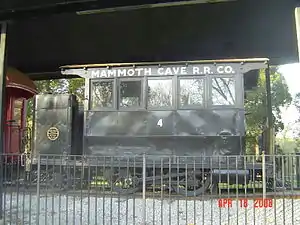Steam dummy
A steam dummy or dummy engine, in the United States and Canada, was a steam locomotive enclosed in a wooden box structure made to resemble a railroad passenger coach.[1] Steam dummies had some popularity in the first decades of railroading in the U.S., from the 1830s but passed from favor after the Civil War. In Europe, locomotives of this type were described as Tram engines.

Overview
It was thought that the more familiar appearance of a coach presented by a steam dummy, as compared to a conventional steam locomotive, would be less likely to frighten horses when these trains had to operate in city streets.[2][3] Later it was realized that it was actually the noise and motion of the operating gear of a steam engine that frightened horses, rather than the unfamiliar outlines of a steam engine.
Production
Baldwin Locomotive Works manufactured Steam Dummy or Steam Motors for many American tramways.[4] Baldwin exported to places such as Sydney, Australia - where they were known as 'steam tram motors' - and New Zealand, where two both built in 1891 survive at Museums today.
H. K. Porter, Inc. preferred the term "noisless steam street motor" in their 20th-century catalog, although they used the term "dummy" (in quotes) in the 19th century. In the 20th century, they offered 0-4-0 and 0-4-2 wheel arrangements.[5] In the 19th century, they also offered a double-ended dummy with a 2-4-2 wheel arrangement.[6] Porter recommended using anthracite or coke as a fuel in order to avoid smoke. Side flaps to hide the mechanism were optional. Operating speeds between 15 and 25 miles per hour (24 and 40 km/h) were reported by 19th-century users.
See also
References
- Debra Brill (2001). History of the J.G. Brill Company. Indiana University Press. pp. 15–. ISBN 0-253-33949-9.
- Ralcon Wagner (3 October 2016). Nashville's Streetcars and Interurban Railways. Arcadia Publishing. pp. 7–. ISBN 978-1-4671-1686-2.
- Jeff Suess (22 June 2015). Lost Cincinnati. Arcadia Publishing. pp. 41–. ISBN 978-1-62619-575-2.
- Baldwin Locomotive Works Illustrated Catalogue of Locomotives, 2nd Ed., Lippincott, Philadelphia, 1881; pages 150-152, with photograph.
- H. K. Porter Company Builders of Light Light Locomotives, 10th Ed., Pittsburgh, 1908; pages 102-105, with photos.
- Light Locomotives, 6th Ed., H. K. Porter & Co., Pittsburgh, 1889; pages 32-33 (0-4-0) and 42-45 (0-4-2 and 2-4-2), 61-66 descriptive text, 94-95 empirical use data.